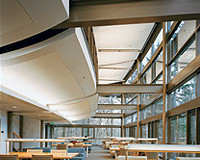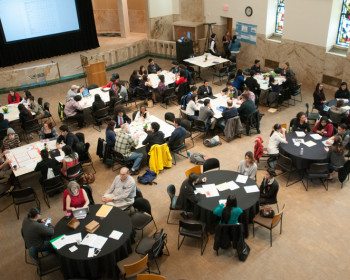Likely to Succeed—Students Overcome Barriers to College Access
“Things are continuing to come together,” says Angela Nusom, a doctoral candidate in Lewis & Clark’s Educational Leadership Program. “The result of this convergence creates the cause. Essentially, what started as a pilot program has a chance to become a model here and elsewhere.”
She’s talking about the Early College Access Advocacy Project. It brings at-risk high school students from Centennial Learning Center, an alternative high school in East Portland (where Nusom is a college-access coordinator), together with graduate-level faculty at Lewis & Clark to answer a burning question: Why do some students go to college, and others not? In their quest to answer the question, they are creating lasting change in their own lives and the lives of their peers.
Chances
Before there was a project, there was the glaring realization that far too many young, powerful minds were being convinced that college wasn’t an option for them. Nusom saw that beyond dialog and debate, the situation needed action.
“The educational system is structured on the belief that all kids have the same chance if they apply themselves and access the opportunities,” Nusom says. “Well, like it or not, there are certain societal structures that slot different people two steps ahead, and others two steps behind. By the time a student winds up in an alternative program, they’ve been told by any number of sources that they’re not worthy of continuing their education.”
Working with a core group of Centennial students – from freshman to recent graduates – Nusom wanted to do more than just talk about overcoming obstacles. She wanted her students to blow past barriers to college access and to help other students in alternative programs do the same.
“You can tell someone that they can do it all you want,” Nusom says. “When they actually start doing it, then they begin to believe in themselves. From there it’s our job as educators to stay on top of them, nudge them forward when they hit a wall, and keep them in check in case they begin to coast.
Reaching out
Nusom wanted to find a home for the project on a college campus, affording her students a chance to feel that much closer to collegiate life. Already part of the Lewis & Clark community, she felt that the graduate school was a natural fit. Upon reaching out to faculty, she soon connected with Dr. Mollie Galloway, director of the Office of Research and Assessment and Dr. Andraé Brown, an assistant professor of Counseling Psychology.
Together, they created a curriculum that would guide students to explore the fundamental question: Why do some students go to college and others not? What leads a student, or a community, to believe college isn’t an option for them? The format has evolved into an all-day class that meets on Lewis & Clark’s campus every Wednesday, all year long. It is defined by deep discussion, problem solving, and strategizing about how to change the fractured dynamic of college access.
“These students have essentially been told, ‘You’re not college material,’” says Galloway, who teaches in the school’s doctoral program. “However, if you walk into a classroom with these kids, you’ll see some of the highest level of discourse you’ll find. I’ve never seen this level of thought from any group of students anywhere.”
Galloway’s work with the students focuses on research, setting the stage for collecting data from other alternative high school students regarding barriers both real and perceived. Meanwhile, Brown infuses a deep sense of critical thinking into his weekly classes.
“Civic engagement is part of what I do personally and professionally,” says Brown. “It’s about saying everyone has an opportunity.”
Once Nusom, Galloway and Brown finalized the curriculum design, the Advocacy and Access program folded smoothly into the graduate school’s Center for Community Engagement. It is one of fourteen projects taking place through the newly launched center.
“Our work in the center ties back to our academic programs, and directly serves the community at large,” says Janet Bixby, associate dean of the Graduate School of Education and Counseling at Lewis & Clark. “Here we have faculty engaging with a doctoral student as well as with each other across departments. We also have high school students working directly with college faculty, studying on campus, and engaging with their peers back in the community. There’s a great sense of community engagement.”
The ripple
The Advocacy and Access project truly begins and ends with the students. Like many of their peers, they found their way into the alternative school as a result of misguided decisions, lack of support, or a sense that somehow, traditional high school wasn’t for them.
For 19-year-old Laborrah Sims, who, while currently being enrolled at Centennial, is also taking nine credit hours at an area community college, it started with something as simple as skipping classes, then soon escalated into fights and eventually expulsion.
“Because I missed classes, I fell behind, which created frustration that I took out on everybody else,” she says. “I never thought I’d be in an alternative program, but here I am. When I tell my old friends I’m in college too, they can’t believe it. “
“It was sort of like destiny,” says 18-year-old Justin Buchanan. “I got in trouble and was expelled from high school. When I got to Centennial, I realized I would have never gotten what I needed at a traditional high school.”
Now Sims, Buchanan, and about 10 others meet once a week on Lewis & Clark’s campus, delving deeply into many of the misconceptions that once held them back.
“I didn’t think college was for me until someone actually started believing in me,” says 18-year-old Jessica Willis. Like Sims, Willis too began her college career while still in high school—with 50 credits to her name by the time she graduated.
“I think college would be best for me now,” adds 14-year-old freshman Cody Randall. “People used to think that I wasn’t capable of something like this. Even my old teachers just figured I wouldn’t be successful.”
When asked if the class is just about preparing for college, Buchanan speaks up.
“It’s about critical consciousness,” he says. “We need critical thinkers.”
“There’s so much to be done,” adds Willis. “It’s almost overwhelming if you look at it all.”
“A lot of policy makers don’t know exactly what to do,” Buchanan continues. “They might see the problems, but they don’t know how to fix them.”
“Plus they’re not in the schools,” Willis goes on. “They’re not getting to the main point of the issue.”
“What we’re doing is taking it to the roots,” Buchanan concludes.
While the project will culminate with a student-generated research report based on surveys, interviews, and focus groups, as well as increased connections meant to help students see new paths, the rewards will truly continue to manifest over time.
“This has allowed us to give back to a lot of kids,” Willis says. “Some of the kids in our class are already taking college classes, and not too long ago none of us thought that was possible. Now we can help other alternative school students realize they’re capable of college too.”
Read a recent Oregonian editorial describing Nusom’s advocacy for continued state funding for high-school students to take college courses, increasing their likelihood of being first-generation college graduates.
More Continuing Education Stories
Center for Community Engagement is located in Rogers Hall on the Graduate Campus.
MSC: 85
email cce@lclark.edu
voice 503-768-6040
fax 503-768-6045
Director Matsya Siosal
Center for Community Engagement
Lewis & Clark
615 S. Palatine Hill Road MSC 85
Portland OR 97219

